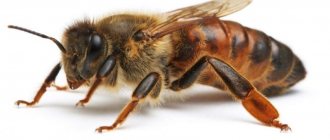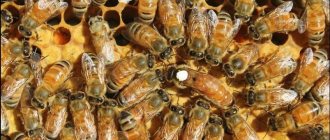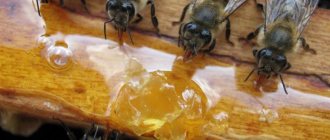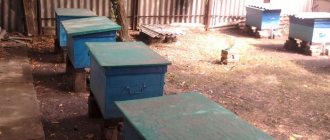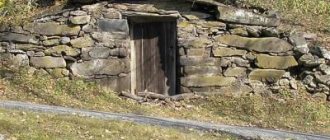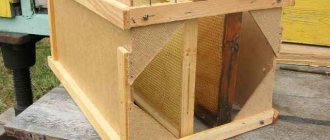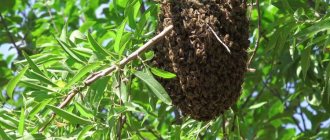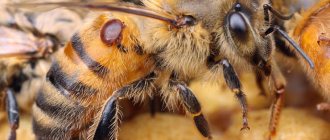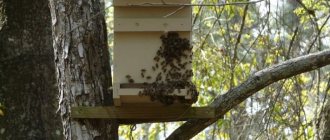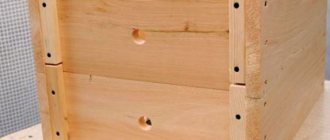Features and Benefits
Keeping double-hull hives means having two compartments, one of which is used directly for keeping bees, and the second for commercial honey. As we know, 12-14 frame dadan is very common, but it loses in comparison with 2 frame ones. Because the latter provide a much greater increase in bee colonies.
And this is far from their only advantage:
- improving the living conditions of bees and, accordingly, improving the quality of their performance;
- increasing space for folding feed and storing honeycombs;
- improving the cell detuning process;
- It is easier to breed insects in Dadan hives, especially with a separating part;
- uniform distribution of work among bees;
- adding a second building to the dadan will increase the space for collecting honey;
- the nest becomes more spacious and air flow improves.
All these factors have a very positive effect on honey production and help bee colonies achieve greater strength and increase their productivity.
Many beekeepers have 12-frame Dadan hives in their arsenal, and these are the ones that can easily be converted into double-frame hives. They are the best suited for such a transformation. You need to make one more body for the old hives; you can use extensions and combine them (two into one). Here, also an important point is the distance between the upper and lower housing (it should not exceed 10 millimeters, but it is better to leave 
Let's consider the features of using this type of hive. A nuance, perhaps, is the fact that the family that occupied the nesting compartment completely occupies the second floor. The beekeeper must keep the second floor from getting too cold, and to do this, they don't put all the frames on top. Over time, as the family grows larger, frames are gradually added until they reach the required number. It turns out that the second building has become a kind of continuation of the nest.
Another interesting feature is that the two families live as completely separate structures, but they have the same uterus. Bees from these families never mix or share!
A hive with this attitude works very well. The family transmits hereditary qualities and this significantly affects the increase in the beekeeper’s “harvest”. If we compare a double-hull hive with a regular one, it should be noted that it produces an order of magnitude more honey!
Types of hives
You can’t just take a couple of boards and build a hive with your own hands without a drawing; after all, this is not a dog kennel. First you must decide on the type. There are only two of them, and they will become the basis for further modifications, so to speak, the basic models. We are talking about horizontal and vertical hives. The first is popularly called a sunbed, and the second is a riser. Both have pros and cons, so we can't say with certainty which design is better.
A vertical model can have two or three tiers, each of which can accommodate about ten frames. It is possible to increase capacity by installing additional stores or cases. The horizontal model is shaped like an elongated box. The initial volume can be increased using new housings that are mounted on the side.
Flaws
If we talk about the disadvantages of this type of bee breeding, then one of them is some inconvenience during the care process. When you need to inspect the sockets of the lower housing, you need to remove the upper one. But this happens extremely rarely. In addition, beekeepers have now adapted to perform inspections without removal.
Another disadvantage is the fact of a sharp increase in the height of the hive. Imagine, the whole process starts in the spring and this transformation leads to a significant cooling of the nest. In summer, insects concentrate their offspring from above, and the lower honeycombs can become clogged, and this limits reproduction in the family located below. However, in beekeeping, many different tricks are now used, and in beekeeping, considering each case separately, you can always find a solution to the problem and circumvent any shortcomings.
Content technology
Maintenance methods, of course, can be different, depending on the area where the hive is located and climatic conditions. But there is a method that is most widely applicable, prescribed by the Institute of Beekeeping
- Since spring, we have been observing how the family develops in the lower building.
- The bees should be well settled in 11-12 frames, of which at least 8 will have brood.
- The stage of installing the next building begins. Three shells with brood need to be transferred to it. It is important that at least one frame already has open brood.
- We add 2 frames with food, which can be removed from spare hives as needed.
- So below we have 8-9 skins, and on top you can put 5.
Important! Make sure that the brood is equally defined in area in both the upper and lower buildings. And also do not forget to insulate the nest well.
Dividing grid
The separating grid plays a very important role in the entire hive. Its main task is to limit drones’ access to the queen, as well as their entry into a certain compartment of the hive.
The structure of the lattice is quite simple and works due to the fact that the size of the drones is significantly smaller than the size of the uterus. This detail also greatly influences the production of marketable honey. After all, if there were no bars, the queen would start laying eggs anywhere, and the lower body would be completely filled with beebread. As a result, a perfectly working family does not produce enough honey!
Frame placement
As we have already said, the number of frames in the cases varies. There are fewer of them in the lower than in the upper. Such arrangements involve labor costs, but they are justified. All sheathings, laid in several rows, must be laid with bundles of paper and fit tightly to each other. The insert board can even be upholstered with fabric or foam rubber. This is necessary so as not to impede the movement of the queen and other bees, as well as to insulate the hive.
After reproduction, the casings are released and their main role is to provide space for the queen to lay eggs. Later we see frames with foundation.
When to put it?
The main thing is to install the second case in time and correctly place the frames in it. If a strong family emerges from wintering, then this should be done in the spring. For a weaker family, this is done when it gains strength after wintering, that is, about a month before the main honey plants begin to bloom. By this time, both buildings should be completely filled with rebuilt honeycombs.
At the beginning of the honey harvest, when the bees carry the first nectar, the combs of the upper body should be free of brood, because this is where the bees will store honey.
You can accurately determine the installation time by looking at the frames of the nesting housing. If out of 12 frames (the standard number for dadan) 8–9 pieces are completely occupied by brood, and there are at least 10 occupied streets, then it’s time to increase the space.
Simplified method
In beekeeping, there is a simpler way of keeping it related to the same method. Let's look at the points:
- Only one, maximum two frames are installed in the housing compartment, which is located at the top
- Individuals of different ages are selected and placed in the hive
- Next, one honeycomb with honey and beebread is placed, from the very edge
- There are no frames left below that contain brood, but only honeycombs with foundation.
Initially, there will be several frames on the top floor; they are separated by a board. And in the nest on the upper floor, frames with foundation are placed, and brood appears in them over time. Next, the queen moves to a new place and begins to lay eggs. On the second floor they increase the amount of foundation; they are constantly moving and working, practically not staying, swarming!
Layering formation
This type of hive involves doubling its size. If honey is collected late, then young bees appear in the hives, there is little space left, so it is impossible to add additional frames with foundation. Swarming begins. To prevent this from happening, part of the brood is taken from the families, which is used to form the layering. They also do this to increase the number of families.
A separate building is built and the second building is placed on the hive, with the entrance in the other direction. The cuttings are sent to the hive with a temporarily imprisoned young queen (this takes one day) and then work with insects develops around her and new honeycombs actively grow. This method is good because young queens rarely swarm and will bring a lot of honey.
What rules must bee housing meet?
There are requests that are common to all hives without exception. This:
- Dryness
- Possessing the ability to retain heat well in winter
- Excellent ventilation
- Matching the optimal volume
- Lightness, convenience, durability
- The presence of drafts in places where parts are connected is unacceptable
Design requirements
Whatever the design of the hive, the following values should remain unchanged:
- The gap between the wall and the side strips of the frames is 0.75-0.8 cm;
- Frame thickness - 2.5 cm;
- The center-to-center distance between adjacent frames is 3.7-3.8 cm.
Material for wooden parts
The following tree species are used to make housing for bees:
- spruce;
- non-resinous pine;
- fir;
- cedar;
- linden;
- aspen.
Wood requirements:
- maximum wood moisture content - 15%;
- If there are holes in the board caused by knots falling out, inserts are made to fill them.
Useful: purchase boards from wood harvested and sawn in winter. It is more resistant to rotting. Summer wood must be thoroughly dried in a special dryer, as it is very juicy.
Wintering
Preparation for wintering begins in the fall, before the end of the main harvest.
Its principles are contained in the following actions:
- Remove young queens in advance;
- Correct and timely growth of more insects for the winter;
- Providing residents with supplies for the winter;
- Correct, neat assembly of nests;
- Preparing premises for their storage.
Results
It should be noted that 2-building content is a very profitable enterprise. Bees retain their working energy longer, the number of frames increases, as does the number of individuals themselves.
The fact that the frames are dispersed over a larger area allows the bees to have more space and increases their productivity. With this method, the swarming instinct of the bee is suppressed. The result is more honey!
But remember, the main principle of care is, of course, the beekeeper’s attention to all the nuances of the process. It is very important to monitor how insects behave, are they comfortable in the living conditions that you have created for them? By following all the rules and adhering to the advice, you can easily master the nuances of keeping bees in a double-hull hive.
Construction of a double-hull hive
Today you can purchase a ready-made double-hull hive or order its production according to an individual drawing. It is possible to make a double-hull beehive with 10 frames yourself. Without going into the intricacies of manufacturing, a drawing of a two-body hive with 12 frames must necessarily have these design details:
- ventilated roof;
- insulation;
- ceiling;
- diaphragm for separating floors;
- bottom.
It is better to make the hive collapsible, where both floors have entrances, and the diaphragm is constructed from bars. A hive with a single queen does not require additional mesh.
The downside of a two-body hive is its heavy weight. The second tier can easily weigh 45 kg, and removing such a huge thing can be quite difficult for one person. The method of keeping bees in double-hull hives with a superstructure has long been implemented and tested by many beekeepers from all over the world. It is this design of the hive that fully satisfies the needs of both humans and insects. Today you can easily find individual systems for breeding and keeping bees in a two-hull hive, which can differ strikingly from the classical algorithm. The design of the hives is also developed at the request of a particular beekeeper, leaving room for useful experiments in the field of beekeeping.
